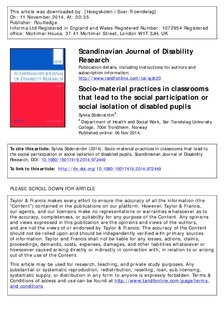| dc.contributor.author | Søderstrøm, Sylvia | |
| dc.date.accessioned | 2014-11-11T12:49:55Z | |
| dc.date.accessioned | 2014-12-09T12:18:41Z | |
| dc.date.available | 2014-11-11T12:49:55Z | |
| dc.date.available | 2014-12-09T12:18:41Z | |
| dc.date.issued | 2014 | |
| dc.identifier.citation | Scandinavian Journal of Disability Research 2014 | nb_NO |
| dc.identifier.issn | 1501-7419 | |
| dc.identifier.uri | http://hdl.handle.net/11250/226876 | |
| dc.description.abstract | Classrooms are comprised of people, relationships, tools, and technologies, which together constitute the socio-material practices of the classroom. This paper investigates how such socio-material practices influence disabled pupils' opportunities for participation in classroom activities. The paper draws on a qualitative observation study with 14 disabled pupils aged 11–15 years. An actor-network theory perspective was employed in this paper, and the analytical process was inspired by an interpretive content analysis approach. The paper's findings highlight the significance of how education is organized for disabled pupils and how disability and assistive technologies (AT) are perceived. Thoughts and beliefs underlying these phenomena were found to be displayed through (1) location in the classroom, (2) teaching strategies, and (3) implementation of AT. The paper concludes that classroom socio-material practices place disabled pupils in a constant flow into and out of social participation and social isolation. | nb_NO |
| dc.language.iso | eng | nb_NO |
| dc.title | Socio-material practices in classrooms that lead to the social participation or social isolation of disabled pupils | nb_NO |
| dc.type | Journal article | nb_NO |
| dc.type | Peer reviewed | |
| dc.date.updated | 2014-11-11T12:49:56Z | |
| dc.source.journal | Scandinavian Journal of Disability Research | nb_NO |
| dc.identifier.doi | http://dx.doi.org/10.1080/15017419.2014.972449 | |
| dc.identifier.cristin | 1171961 | |
